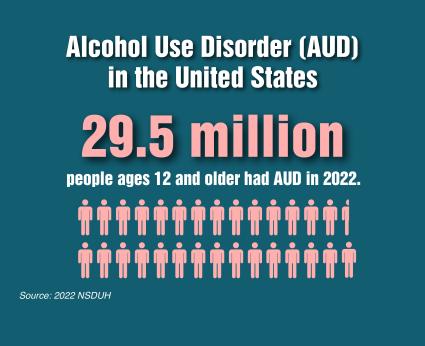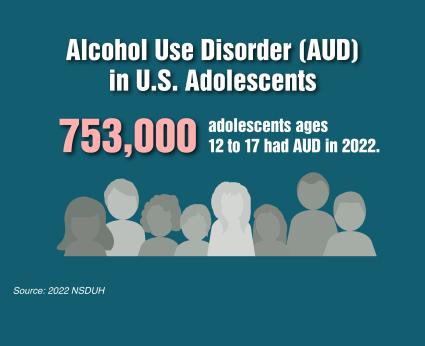Alcohol Use Disorder (AUD) in the United States: Age Groups and Demographic Characteristics
Prevalence of Past-Year Alcohol Use Disorder (AUD)
People Ages 12 and Older

According to the 2022 National Survey on Drug Use and Health (NSDUH), 29.5 million people ages 12 and older (10.5% in this age group) had AUD in the past year.1,2 This includes:
- 17.4 million males ages 12 and older (12.6% in this age group)1,2
- 12.2 million females ages 12 and older (8.5% in this age group)1,2
- 154,000 American Indian or Alaska Native people ages 12 and older (10.5% in this age group)1,2
- 958,000 Asian people ages 12 and older (5.6.% in this age group)1,2
- 3.6 million Black or African American people ages 12 and older (10.5% in this age group)1,2
- 18.6 million White people ages 12 and older (10.9% in this age group)1,2
- 609,000 people of two or more races ages 12 and older (10.4% in this age group)1,2
- 5.5 million Hispanic or Latino people ages 12 and older (10.8% in this age group)1,2
- Estimates for Native Hawaiian or other Pacific Islander people ages 12 and older were not presented because they were based on a relatively small number of respondents or had a large margin of error.1,2
Youth Ages 12 to 17

According to the 2022 NSDUH, 753,000 youth ages 12 to 17 (2.9% in this age group) had AUD in the past year.1,2 This includes:
- 281,000 boys ages 12 to 17 (2.1% in this age group)1,2
- 472,000 girls ages 12 to 17 (3.8% in this age group)1,2
- 10,000 American Indian or Alaska Native youth ages 12 to 17 (4.7% in this age group)1,2
- 28,000 Asian youth ages 12 to 17 (1.8% in this age group)1,2
- 55,000 Black or African American youth ages 12 to 17 (1.6% in this age group)1,2
- 406,000 White youth ages 12 to 17 (3.2% in age group)1,2
- 28,000 youth of two or more races ages 12 to 17 (3.5% in this age group)1,2
- 225,000 Hispanic or Latino youth ages 12 to 17 (3.4% in this age group)1,2
- Estimates for Native Hawaiian or other Pacific Islander youth ages 12 to 17 were not presented because they were based on a relatively small number of respondents or had a large margin of error.1,2
Adults Ages 18 and Older
According to the 2022 NSDUH, 28.8 million adults ages 18 and older (11.2% in this age group) had AUD in the past year.1,2 This includes:
- 17.1 million men ages 18 and older (13.6% in this age group)1,2
- 11.7 million women ages 18 and older (8.9% in this age group)1,2
- 143,000 American Indian or Alaska Native adults ages 18 and older (11.5% in this age group)1,2
- 929,000 Asian adults ages 18 and older (6.0% in this age group)1,2
- 3.6 million Black or African American adults ages 18 and older (11.0% in this age group)1,2
- 18.2 million White adults ages 18 and older (11.5% in this age group)1,2
- 580,000 adults of two or more races ages 18 and older (11.5% in this age group)1,2
- 5.3 million Hispanic or Latino adults ages 18 and older (11.9% in this age group)1,2
- Estimates for Native Hawaiian or other Pacific Islander youth ages 12 to 17 were not presented because they were based on a relatively small number of respondents or had a large margin of error.1,2

